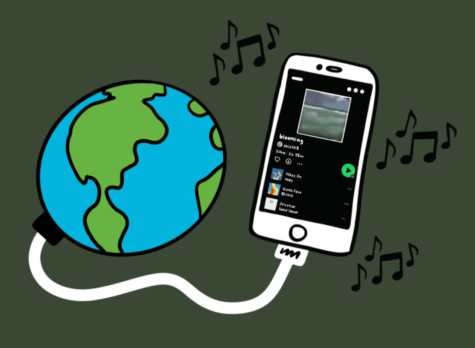The future is here: The Tribune previews and analyzes 2015 technology
Earlier last month, the Consumers Electronics Show (CES) took place, giving us a glimpse into the future of tech for 2015. Hundreds of new electronics devices were revealed this show, but instead of digging through heaps of internet articles, here are the devices that will really impact your life this year.
-
- LG G Flex 2: The LG G Flex 2 was easily the most impressive cellular device at the show. LG, learning off their horrendous failure of the original G Flex, has completely revamped the phone with a more subtle curve, top of the line specs, and decent build quality, bringing the G Flex 2 on par with current flagship devices. Taking cues of it’s very successful non-curved counterpart, the LG G3, the G Flex 2 incorporates the same brushed faux aluminum backing that delivers a premium feeling in the hand. Unlike the first G Flex, the G Flex 2 is seeking to break the bank, with rumors of a $600 off contract price, and a $200 for a two year contract price. The LG G Flex 2 seems like a very promising device, but we will have to wait for the official release to see if the phone will be a commercial success. The question still remains however, are curved displays like the LG G Flex 2 the future of cell phone displays?
- ASUS Zenfone 2: The ASUS ZenFone 2 is the only phone that can boast that it probably has as much RAM as your pre built computer, 4GB. The ZenFone 2 is the first phone to ever feature 4GB of RAM, though it is unlikely you will ever end up using that much on your cell phone. If you are an intense multitasker, that keeps many RAM intensive applications open at the same time, well then look no further because the ZenFone 2 is the perfect phone to you. The ZenFone 2 is one of the only phones on the market that is backed by an Intel based processor, but don’t be scared off by ASUS’s deviance from the norm of Qualcomm, as the Intel Atom Z3580 is more than enough power to keep this phone going in all tasks demanded by the user. The ASUS ZenFone 2 pricing is still unknown for the 4GB RAM variant, but starting at $199 off contract, you can pick up the 2GB RAM model.
- Sling TV: If there’s one thing I strongly believe in is that companies like AT&T and Comcast are harming the development of this country. These companies heavily overcharge for services like cable and internet (due to passing laws in their favor, and buying out the competition, essentially establishing monopolies where you have no choice in your area as to which provider you can choose) causing the halt of America’s infrastructural growth resulting in America being left behind as the leader in technologies such as internet speed. Dish’s Sling TV, aims to dethrone these cable cartels by offering the ability to subscribe to basic channels for $20 and steam them to devices such as your cell phones (iOS or Android), Chromecast, Amazon Fire TV, Android TV, Xbox One, select LG and Samsung Smart TVs, and Rokus. With this $20 package you receive ESPN, ESPN2, CNN, TBS, TNT, Cartoon Network, Adult Swim, Travel Channel, Food Network, ABC Family, HGTV, Disney Channel and Maker, more than enough to keep the average American citizen busy. Let’s face it, how many channels out of your cable plan do you actually watch? Sling TV seems like a promising alternative to your hefty cable bills, but still doesn’t seem good enough for many users who wouldn’t want to lack their favorite channels like History, History 2, American Heroes Channel, and the Science Channel. It will remain to be seen whether the major internet service providers will throttle our speeds with this service like they have done with other streaming services like Netflix, YouTube, and Hulu.
- Quantum Dot TVs: Quantum Dot TVs are a new technology of TVs that seem to be drawing a lot of attention, but many people don’t know exactly what they are. To understand exactly how this new technology works, one must understand how the technology we have today works. Popular forms of displays we have today are LCD, LED, and OLED. LCD, the most date of these three, uses fluorescent tubes to create white light, this light then passes through pixels on the display, the white light is then altered by crystals on the display producing different colors. The downside to this technology is that the blacks give out a washed out color, energy costs are higher, and it requires more space. LED is essentially the same technology as LCD, with a few minor tweaks. LED backlighting outputs less heat, draws less power, and can fit in much smaller of a form factor. LED backlights also emit a blue backlight, which then has to pass through filters on the screen to be the correct color, which results in blacks appearing brighter than they should be, in attempts to solve this problem the LED backlight is dimmed in darker areas of the screen, but the image displayed still has it’s flaws. OLED doesn’t require any backlight on the other hand, since the elements required for producing colors are built in to the display. These elements can produce their own light, giving the experience of brighter colors, and much deeper, true to life blacks since it can turn off the pixels that require a black color resulting in a very power efficient experience.
Quantum Dot TVs are simply LED TVs with crystals added above the backlight used to alter the light and create a richer white light that has all colors of the spectrum. Though I haven’t seen one myself, reports are the colors are more accurate to something of an OLED display. The appeal of Quantum Dot lies heavily in the potential cheaper manufacturing costs. OLED TV’s are costly, and require more labor to manufacture, whereas Quantum Dot TV’s simply add an extra layer of film to the TV, and in theory should cost less, however as of right now are the exact opposite. But as time goes on and the demand for these Quantum Dot TVs increases, the prices should come down, making the TVs cheaper for the average consumer.
-
- LG WebOS Smartwatch: One of the most interesting wearables at CES was the LG WebOS power smartwatch specifically designed for a new model of an Audi vehicle. The watch can unlock and lock your car doors, and complete other menial tasks, but the interesting part lies within the OS. We’ve never seen or even heard about an Android Wear smartwatch, so we LG subtly showed off this watch, it certainly raised a lot of eyes. WebOS seems like a worthy Android Wear competitor already, with an easy layout rather than the unpredictable cards system, and runs with smooth animations already. The watch, unlike an Android Wear device, has cellular connectivity, which allows for a built in phone dialer and messaging apps. Though it’s unclear whether a variant of this device will be available without the car, one thing is certain, the interest for a WebOS smartwatch is certainly in the market.
- Self-Lacing Nike Shoes (Was not at CES): The vision of self lacing shoes seen nearly 30 years ago in Back to the Future 2 is finally becoming a reality. Nike has announced their plans for “Power Laces”, bringing self-lacing technology to their Nike Mag shoes. Though the pricing information still unavailable, it is assumed the price will be out of reach for many consumers to purchase. It may be some time until we see everyone wearing shoes equipped with power laces, but this is one small step for mankind.
- Dell Venue 8 7840: The Dell Venue 8 7840 is Dell’s newest Android tablet this decade, but unlike the previous tablets from Dell before this, this tablet is raising a lot of heads. The Venue 8 7840 is the thinnest tablet you can get right now, coming at a mere 6mm. Even though the 7840 has a strikingly slim design, Dell has managed to fit a powerhouse into this thin body, with an 8.4 inch 2560 x 1600 (1600p) OLED display, 2GB of RAM, and a top of the line Intel Atom Z3580 processor. If you are in the market for a tablet, this is the one to get.
- Energous WattUp Charging System: It’s 2015, and by now we’ve all seen QI wireless charging, but the Energous WattUp Charging System is seeking to refine the whole meaning of wireless charging. The way QI wireless chargers work is you place your QI wireless charging enabled device onto a QI wireless charging pads (which is pulled into an outlet) to seamless begin the charging of your device without any confusion of cords. Energous is completely ditching the QI wireless charging standard with their device, and is opting for a new form of wireless charging that will allow you to charge your device as long as you are within 30 feet of a WattUp Charging System receiver. No charging pads, or cords, simply being within the range will allow your device to pick up a charge as long as it has a compatible chip built into it. The way this tech works is a WattUp transmitter sends energy via radio waves to paired devices containing WattUp receivers, which is then converted to DC power, which charges the device’s battery. A neat form of charging, but one that I was concerned about due to the potential cancer risks. However, WattUp runs on the same radio frequency as WiFi routers, which reassured me that this form of charging is completely safe so long as the device being charged is not on your person. The Energous WattUp Charging System is a bold new way to charge your electronic devices, and a fascinating glimpse into what the technology industry has to offer in the year of 2015.
Shows like CES 2015 have opened this year up with a bang, showing us consumers a bright that lies ahead in the tech industry this year. Though many release dates still may be up in the air, this year will certainly be a big one for electronics.



















